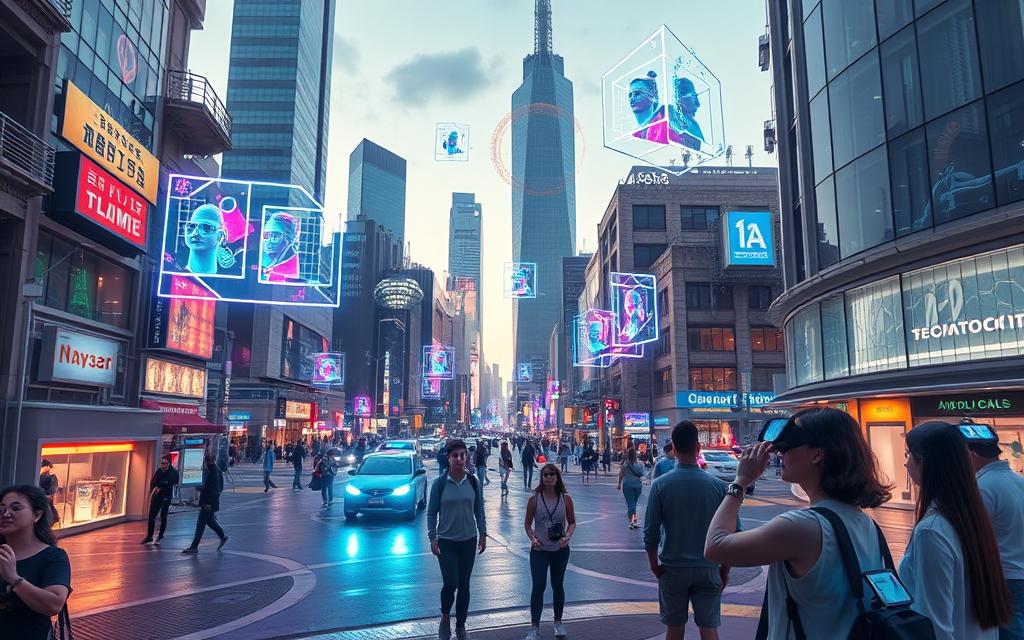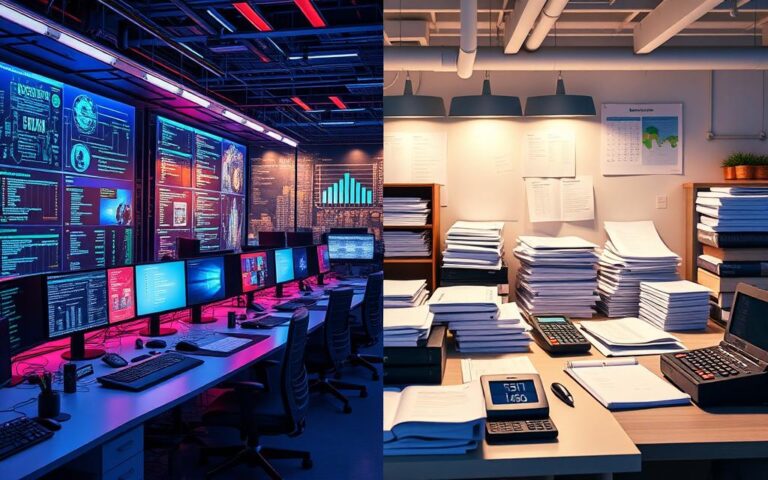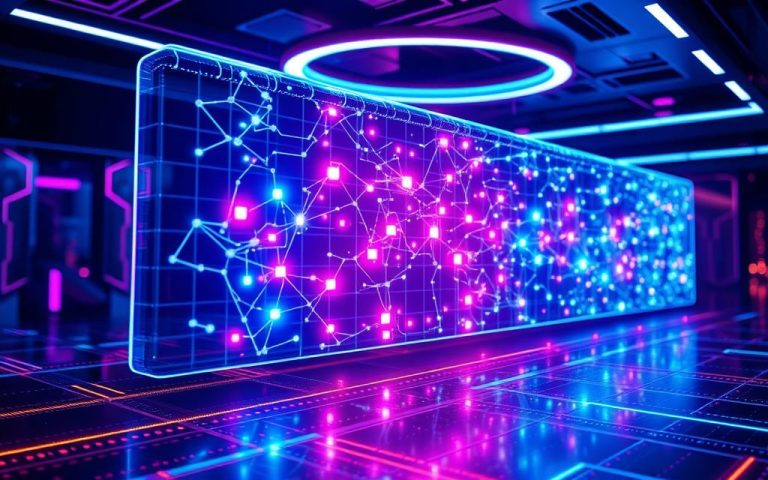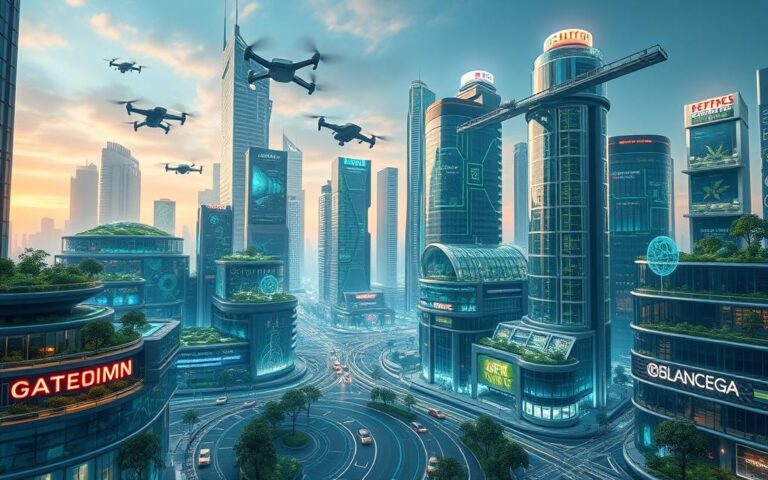How Augmented Reality (AR) Technology Functions
Augmented reality (AR) combines digital elements with the real world. It makes experiences more engaging by overlaying computer visuals and sounds onto what we see and hear. This is done using smartphones, tablets, and advanced software. It allows us to interact with information in new ways.
Investments in AR are growing quickly. They’re predicted to hit $45.1 billion by 2022 and may go up to $50.2 billion by 2024. AR is changing many sectors such as retail, healthcare, and manufacturing. In retail, it creates immersive shopping experiences. In healthcare, it assists in surgeries and education. This technology is paving the way for a future where digital elements are part of our daily lives.
Understanding Augmented Reality (AR)
Augmented reality (AR) mixes digital and real-world elements. It places computer-generated content, like images and sounds, into our real-world setting. The definition of AR shows its power to change how we interact with our surroundings. Unlike virtual reality, AR adds to real life by bringing in virtual features. This has made AR popular, as it makes real-world experiences more informative and engaging.
Different fields are now using AR to showcase 3D models of machines right in the environment. This shows that AR is becoming crucial, not just for adverts but for practical tasks too. There’s a good mix of AR for both personal and professional use. Games like Pokémon GO and Snapchat filters show how AR keeps users interested and involved.
Using AR comes with challenges such as technical limits that can affect the AR experience in various settings. Developing advanced AR apps can be costly, but the improvement in user interaction is often worth it. Privacy concerns have also been raised by users. Yet, the use of AR is growing fast, promising major improvements in how we experience the world.
To really understand AR, it’s important to look more into how it works and keeps evolving. The many ways it’s used are key to seeing how powerful AR can be.
How Does Augmented Reality Technology Work
Augmented reality (AR) mixes digital info with the real world in a seamless way. It uses both AR hardware and software. Important parts like smartphones in AR, AR glasses, and sensors help create vivid experiences.
The Role of Hardware in AR
At its core, AR technology depends on its hardware. This includes smartphones, tablets, and AR glasses. They have cameras and sensors to understand our surroundings. This lets them produce real-time data that’s key for AR to work well.
Advanced sensors such as accelerometers and gyroscopes track how we move. This makes sure digital content blends well with the real world. It helps users feel like the virtual and physical worlds are one.
The Importance of Software in AR
AR software takes the data from the hardware and makes it useful. It uses complex algorithms to build and adjust digital layers for AR applications. This software is crucial for software functions in AR like recognizing objects and interacting without delay.
It makes sure the augmented parts fit well with real places. As AR tech gets better, artificial intelligence is making data processing even better. This means better interactions and more engaging experiences for users.
Types of Augmented Reality
Augmented Reality (AR) has different types that serve various purposes. Each type uses special technologies. These technologies help blend digital content with the real world. Understanding the main types can explain their features and how they are used.
Marker-based AR
Marker-based AR uses specific signals, like QR codes, to show digital items. This means your device can see these markers and put virtual objects on them. It’s great for ads and learning because it makes information easy to get. By scanning a marker, people can see fun, interactive content. This makes learning and exploring fun.
Markerless AR
Markerless AR doesn’t need special markers. It uses GPS and cameras to work with what’s around you. It is shown in games like Pokémon Go. This game uses your location to create a fun game world. This type is used for finding places and decorating your home too.
Projection-based AR
Projection-based AR shines a virtual world on real things. It blends digital and real, making an interface people can use. It’s used in showing buildings and displays. It lets people see how virtual ideas can add to the real world. This mix makes AR more engaging.
| Type of AR | Description | Applications |
|---|---|---|
| Marker-based AR | Relies on predefined markers to activate content. | Advertising, education, interactive experiences. |
| Markerless AR | Utilises environmental data for spatial recognition without markers. | Navigation, gaming, interior design. |
| Projection-based AR | Projects virtual content onto physical surfaces. | Architecture, exhibitions, interactive displays. |
New AR applications are becoming popular. Knowing these types is key to using their advantages in different areas. They offer new ways to blend real and digital worlds. This excites both creators and users to try out new experiences.
For more details on AR technology, check out this resource.
The Technology Behind AR Experiences
Augmented reality, or AR, blends real and virtual worlds in an amazing way. It uses special tracking, mapping, and visual tech. This makes it possible for virtual and real elements to merge smoothly, making our interactions richer.
Tracking and Mapping Techniques in AR
Digital elements can appear right where they belong in the real world, thanks to AR tracking. It uses different methods:
- Marker-based AR: This relies on visual markers to place digital content.
- Markerless AR: It maps the environment and adds digital elements without needing special markers. This is more flexible.
- Projection-based AR: This method makes objects interactive by projecting images onto them.
SLAM technology is especially cool. It maps out our surroundings in real-time. This is key for placing objects accurately in AR, making experiences feel more real. It helps virtual and real worlds sync up better.
Display and Visualisation Technologies
For AR to work, we need super smart display technologies. They let users see and interact with virtual elements. We use different devices for this:
- Smartphones and Tablets: These are the most common ways to experience AR. They’re easy to carry and use.
- Smart Glasses: With these glasses, digital content appears right in your line of sight, hands-free.
- Screen Technologies: We need top-notch screens to make digital content look real and interactive.
Mixing advanced hardware with smart software is a must for creating cool AR visuals. Cameras and sensors pick up on details in our environment. Then, clever algorithms turn this info into live virtual scenes. This keeps the AR experience smooth and fun.
| Tracking Techniques | Description | Applications |
|---|---|---|
| Marker-based AR | Utilises visual markers as reference points | Education, marketing materials |
| Markerless AR | Uses environmental features for tracking | Retail, navigation apps |
| Projection-based AR | Projects virtual images onto physical surfaces | Exhibitions, interactive installations |
Applications of Augmented Reality
Augmented reality (AR) is making a big impact in many areas, proving it can change our lives. It makes shopping more fun and medical training better. AR is changing how we see the world in lots of different industries.
AR in Retail and Marketing
In retail, brands use AR to make shopping better. Shops like Farfetch and Prada use it for cool marketing. They let people try clothes on digitally, making shopping fun and easy. Customer engagement with AR means people understand products better and buy more. It makes going to the shop a better experience.
Augmented Reality in Healthcare
The health sector benefits a lot from AR in healthcare. Doctors use AR to learn about the body in 3D. It helps them get better at their jobs, which is great for patient care. They can practice surgeries in a more realistic way before the real thing.
AR Uses in Education and Training
AR is changing learning in schools too. It makes lessons more fun and helps students see complicated topics clearly. Interactive learning with AR means students work together more and enjoy lessons. These training applications with AR are making learning something everyone looks forward to.
Comparing Augmented Reality, Virtual Reality, and Mixed Reality
In our digital world, it’s key to know how AR, VR, and MR differ. Looking into AR and VR shows us new ways people can experience technology. Mixed reality combines these, offering unique interactions. Recognizing their differences helps us understand their contributions to how we interact with tech.
Differences Between AR and VR
Differences between AR and VR are mainly about how they work. AR adds digital items to our real world. It lets us interact with both real and virtual things. On the other hand, VR takes us to a completely made-up world, cutting off the real world. These technologies have led to different uses in business:
- AR lets shoppers see how furniture from IKEA looks in their own spaces.
- VR offers real-like training for healthcare and aviation workers.
- AR helps doctors model diseases in hospitals.
- Pilots use VR to experience flight scenarios with headsets.
Mixed Reality Explained
Mixed reality blends the real and virtual worlds for interactive experiences. The idea of mixed reality is about more than just showing digital information. It’s about real and digital life working together. The automotive and tech industries use MR for things like design, sales, and teamwork:
- Big names like Microsoft and Ford are adopting mixed reality for diverse tasks.
- Travellers can have enhanced adventures with MR apps.
- It makes virtual items feel like they’re right in front of you, showing the power of AR and VR together.
The future of AR, VR, and MR is bright, offering more chances in many areas. They are changing how we experience the world and improving how businesses operate.
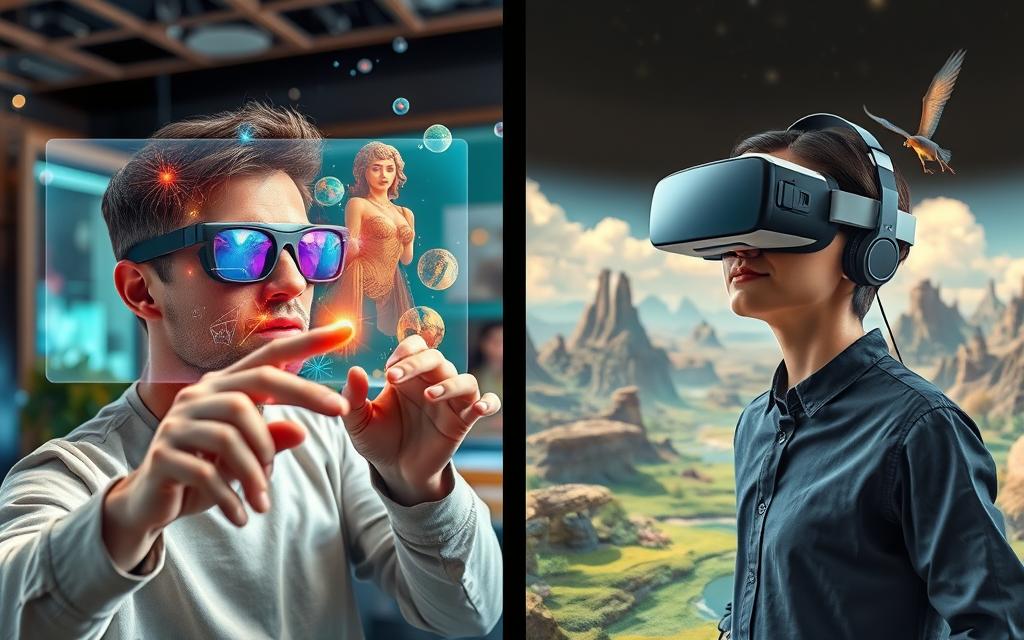
Advantages of Augmented Reality Technology
Augmented Reality (AR) technology brings many advantages across different areas. It creates immersive experiences that enhance how users and businesses interact. Exploring AR’s impact on user experiences and its commercial benefits shows why it’s valuable.
Enhancing User Experience with AR
AR changes the way we do daily tasks by improving user experience. It makes interacting with digital content interactive and fun. Here are some ways AR betters user experiences:
- Interactive Features: Users can engage with 3D models for a stronger connection to content.
- Real-Time Information: Instant data access makes tasks more efficient.
- Gamified Elements: Game-like experiences increase fun in learning and shopping.
Benefits for Businesses
AR offers loads of benefits to businesses, encouraging growth. Companies use AR to improve and connect better with customers. Here are some of AR’s business benefits:
- Cost Savings: IT remote help with AR cuts costs and downtime.
- Increased Engagement: Virtual try-ons in retail boost sales and the shopping experience.
- Educational Improvements: AR in healthcare makes surgeries more precise. This betters medical training and patient care.
- Enhanced Collaboration: AR helps in product development by allowing better real-time visualisation, thus saving costs.
| Industry | Benefits of AR |
|---|---|
| Education | More engagement and better learning retention. |
| Healthcare | Better surgical accuracy and improved diagnoses. |
| Retail | Virtual try-ons lead to more sales. |
| IT Support | Cost cuts and stronger teamwork among technicians. |
As AR tech grows, it will keep improving how we experience AR and the business opportunities it brings. This lets businesses better connect with customers and streamline their operations.
Conclusion
The way we see the world is changing, thanks to augmented reality (AR). This AR technology overview covers its journey from the 1960s until now. It’s now used in healthcare, education, and marketing. This shows how impactful AR is in our daily lives and different work areas.
AR is getting better with advancements in technology. High-quality sensors and platforms like ARKit and Unity make it better. These improvements make user experiences more interactive. They push for new ways of connecting, which seemed impossible before. Now, 61% of shoppers prefer stores that use AR for a better buying experience.
Experts think the market for AR, VR, and mixed reality will be more than $100 billion by 2026. We are at the edge of an era filled with change. As we figure out how to use AR and keep data safe, its potential is huge. The future of AR looks bright. It will change how we live, work, and connect with each other.
FAQ
What is Augmented Reality (AR)?
Augmented Reality (AR) overlays digital content like images and sounds onto real-world scenes. This enhances how users interact with their environment.
How does Augmented Reality work?
AR works by combining devices like smartphones and smart glasses with software. This software uses device sensors to put digital overlays on the real world.
What types of Augmented Reality exist?
AR can be marker-based, using set markers to show content. Markerless AR uses features in the environment to place objects. Projection-based AR puts virtual content onto physical surfaces.
How is AR used in retail?
In retail, AR helps shoppers see products in their own space. This boosts customer interest, creates new marketing ideas, and increases sales.
Can Augmented Reality be used in healthcare?
Yes, in healthcare, AR supports training by showing 3D body structures. It improves medical education and procedures.
What are the differences between Augmented Reality and Virtual Reality?
AR adds digital elements to the real world. Virtual Reality (VR), however, creates a completely digital world, cutting off the real world.
What is Mixed Reality (MR)?
Mixed Reality (MR) combines AR and VR. It lets users engage with both real and virtual settings for a richer experience.
How does AR improve user experience?
AR makes user interactions more immersive. It turns activities like shopping and gaming more fun, enhancing user involvement.
What are the benefits of Augmented Reality for businesses?
AR boosts customer interaction, improves marketing, gathers important consumer data, and increases sales. This strengthens brand loyalty.
